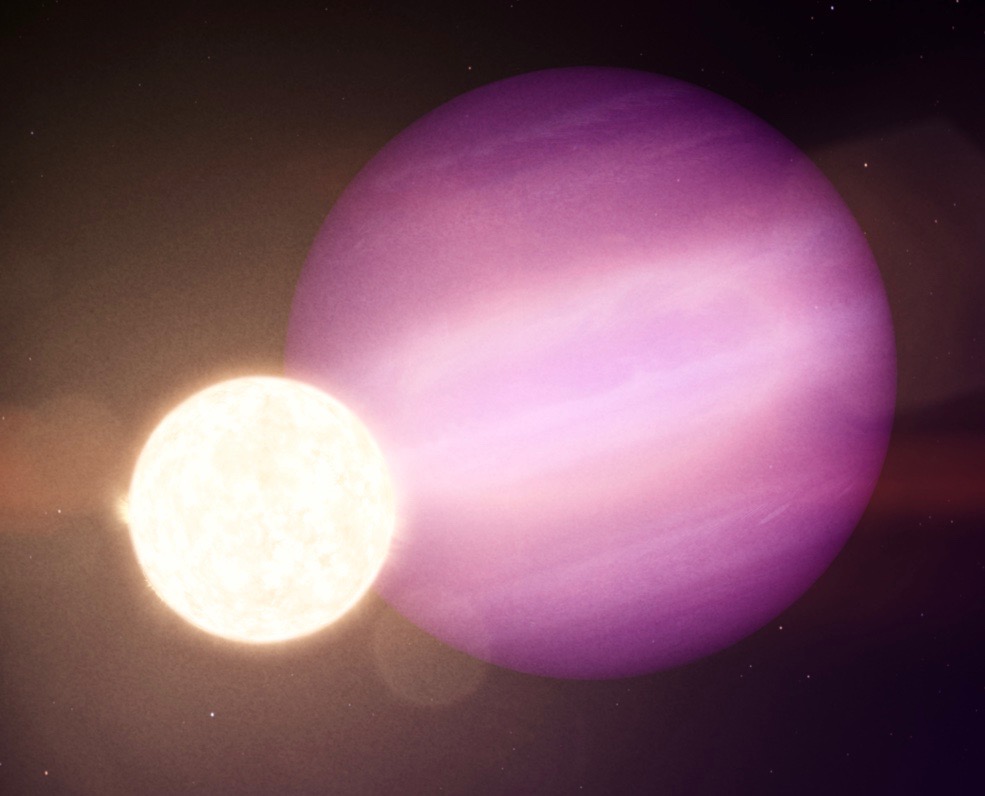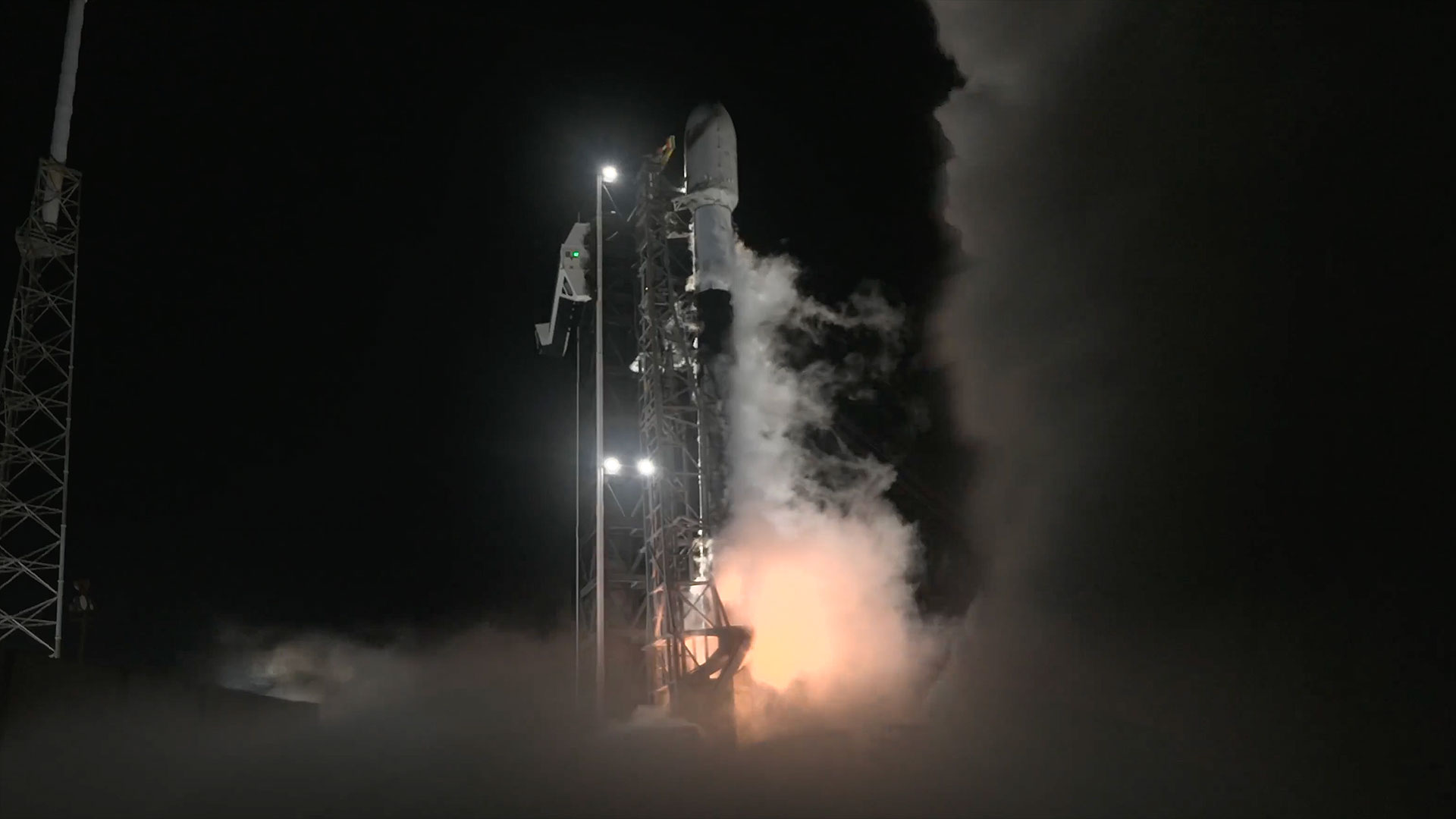We may now have direct evidence that planets can survive unscathed the violent churn that attends their host star's death.
Astronomers have spotted signs of an intact giant planet circling a superdense stellar corpse known as a white dwarf, a new study reports.
The white dwarf in question, called WD 1856, is part of a three-star system that lies about 80 light-years from Earth. The newly detected, Jupiter-size exoplanet candidate, WD 1856 b, is about seven times larger than the white dwarf and zips around it once every 34 hours.
Related: The strangest alien planets (gallery)
"WD 1856 b somehow got very close to its white dwarf and managed to stay in one piece," study lead author Andrew Vanderburg, an assistant professor of astronomy at the University of Wisconsin-Madison, said in a statement.
"The white dwarf creation process destroys nearby planets, and anything that later gets too close is usually torn apart by the star's immense gravity," Vanderburg said. "We still have many questions about how WD 1856 b arrived at its current location without meeting one of those fates."

The first of its kind (potentially)
Vanderburg and his colleagues found WD 1856 b using NASA's Transiting Exoplanet Survey Satellite (TESS), which hunts for alien worlds by noting the tiny brightness dips they cause when transiting, or crossing their host stars' faces from the spacecraft's perspective.
Breaking space news, the latest updates on rocket launches, skywatching events and more!
The team then studied the system in infrared light using NASA's Spitzer Space Telescope shortly before the observatory's January 2020 decommissioning. The Spitzer data showed that WD 1856 b is emitting no infrared glow of its own, suggesting that the object is a planet rather than a low-mass star or a brown dwarf, a body that straddles the hazy line between planets and stars.
Still, WD 1856 b remains a candidate planet for now, awaiting confirmation by further analyses or observations.
You wouldn't necessarily expect white dwarfs to be promising targets for TESS and other planet hunters, considering the process that forms them.
When sunlike stars run out of hydrogen fuel, they bloat into red giants that engulf and incinerate anything orbiting nearby. For example, our own sun will destroy Mercury, Venus and perhaps Earth when it becomes a red giant, about 5 billion years from now. Red giants eventually collapse into white dwarfs, which typically pack the mass of our sun into a sphere only slightly bigger than Earth.
It's therefore safe to say that WD 1856 b didn't form at its current location; the object would never have survived WD 1856's red-giant phase. Indeed, the study team's calculations suggest that the candidate planet must have been born about 50 times farther away from the star than its current location, then migrated in.
"We've known for a long time that after white dwarfs are born, distant small objects such as asteroids and comets can scatter inward towards these stars. They're usually pulled apart by a white dwarf's strong gravity and turn into a debris disk," study coauthor Siyi Xu, an assistant astronomer at the international Gemini Observatory in Hawaii, said in the same statement.
"That's why I was so excited when Andrew told me about this system," Xu said. "We've seen hints that planets could scatter inward, too, but this appears to be the first time we've seen a planet that made the whole journey intact."
It's unclear what gave WD 1856 b its inward push. Possibilities include nudges from the other two stars in the WD 1856 system and a brief interaction with an intruding "rogue star," wrote team members in the new study, which was published online today (Sept. 16) in the journal Nature.
But "the most likely case involves several other Jupiter-size bodies close to WD 1856 b's original orbit,” coauthor Juliette Becker, a planetary scientist at the California Institute of Technology in Pasadena, said in the same statement.
"The gravitational influence of objects that big could easily allow for the instability you'd need to knock a planet inward," Becker said. "But at this point, we still have more theories than data points."
No other planets have been spotted in the WD 1856 system, but that doesn't mean none are there, study team members said.
Related: NASA's TESS exoplanet-hunting mission in pictures
Rocky planet survivors, too?
WD 1856 b's apparent existence has exciting consequences for planetary scientists and astrobiologists. For example, if a gas giant can survive a sunlike star's death, then huddle close enough to the burnt-out corpse to suck up significant warmth, couldn't a rocky, Earth-like world do so as well?
Vanderburg and other researchers investigated this possibility in a companion paper, which was published today in The Astrophysical Journal Letters. The team, led by Cornell University researchers Lisa Kaltenegger and Ryan MacDonald, used computer modeling to simulate the looks that NASA's upcoming James Webb Space Telescope could get at a hypothetical rocky world orbiting in the "habitable zone" of WD 1856.
The habitable zone is that just-right range of orbital distances where liquid water could be stable on a world's surface.
The researchers determined that Webb, a $9.8 billion flagship observatory scheduled to launch in October 2021, could spot the signatures of water and carbon dioxide in such a planet's air after observing just five transits.
"Even more impressively, Webb could detect gas combinations potentially indicating biological activity on such a world in as few as 25 transits," Kaltenegger, the director of Cornell's Carl Sagan Institute, said in the same statement.
"WD 1856 b suggests planets may survive white dwarfs' chaotic histories," Kaltenegger said. "In the right conditions, those worlds could maintain conditions favorable for life longer than the time scale predicted for Earth. Now we can explore many new intriguing possibilities for worlds orbiting these dead stellar cores."
Editor's note: This story was updated at 5:45 p.m. ET on Sept. 19 to state that the James Webb Space Telescope could spot water and carbon dioxide in the air of a hypothetical rocky planet orbiting WD 1856 after observing just five transits. The original version said oxygen and carbon dioxide, which is not correct.
Mike Wall is the author of "Out There" (Grand Central Publishing, 2018; illustrated by Karl Tate), a book about the search for alien life. Follow him on Twitter @michaeldwall. Follow us on Twitter @Spacedotcom or Facebook.
Join our Space Forums to keep talking space on the latest missions, night sky and more! And if you have a news tip, correction or comment, let us know at: community@space.com.

Michael Wall is a Senior Space Writer with Space.com and joined the team in 2010. He primarily covers exoplanets, spaceflight and military space, but has been known to dabble in the space art beat. His book about the search for alien life, "Out There," was published on Nov. 13, 2018. Before becoming a science writer, Michael worked as a herpetologist and wildlife biologist. He has a Ph.D. in evolutionary biology from the University of Sydney, Australia, a bachelor's degree from the University of Arizona, and a graduate certificate in science writing from the University of California, Santa Cruz. To find out what his latest project is, you can follow Michael on Twitter.
-
rod The space.com report makes it clear this is a planet candidate, there will be follow ups to confirm. I note this in the report.Reply
"It's therefore safe to say that WD 1856 b didn't form at its current location; the object would never have survived WD 1856's red-giant phase. Indeed, the study team's calculations suggest that the candidate planet must have been born about 50 times farther away from the star than its current location, then migrated in. "We've known for a long time that after white dwarfs are born, distant small objects such as asteroids and comets can scatter inward towards these stars. They're usually pulled apart by a white dwarf's strong gravity and turn into a debris disk," study coauthor Siyi Xu, an assistant astronomer at the international Gemini Observatory in Hawaii, said in the same statement. "That's why I was so excited when Andrew told me about this system," Xu said. "We've seen hints that planets could scatter inward, too, but this appears to be the first time we've seen a planet that made the whole journey intact." It's unclear what gave WD 1856 b its inward push. Possibilities include nudges from the other two stars in the WD 1856 system and a brief interaction with an intruding "rogue star," wrote team members in the new study, which was published online today (Sept. 16) in the journal Nature."
if confirmed the exoplanet will be challenging to explain like the report shows, migrating inwards by some 50x from its potential present location at the WD host star. Other reports indicate the candidate could be at least 14 Jupiter masses, A giant planet candidate transiting a white dwarf, https://www.nature.com/articles/s41586-020-2713-y
I plan to monitor further reports on this very interesting exoplanet candidate. -
Helio I'm curious with what makes it so surprising to astronomers? The phase prior to becoming a WD had massive gas outflows that would, I think, cause serious migration of all the objects that were orbiting. If the massive ones were far enough out -- the article suggests 50x what it is now -- then it would survive the migration since the mass flows eventually ended, as it's now a WD. They mention gravity destroys such objects, but a WD is much weaker in gravity than when all the objects orbited normally. So are they implying that the migration creates huge eccentricity such that their close approach is within the Roche limit? That seems unlikely.Reply -
annodomini2 As the white dwarf is formed, the red giant sheds it's outer layers, wonder what modelling would show if a deep orbit gas giant could absorb a lot of this gas and spiral inwards as a result.Reply
Or even more extreme, the blasted off gas forms a new planet -
rod Helio et al. This site is now reporting the nearly 14 Jupiter mass exoplanet, https://exoplanetarchive.ipac.caltech.edu/overview/WD%201856+534Reply
The exoplanet is listed at 13.8 Jupiter mass, radius= 0.928 Jupiter so the mean density ~ 21 g cm^-3, orbital period near 1.4 days and WD host star 0.52 solar masses. *Big find!* I am not so sure about this :) There are other WD listed as confirmed with exoplanets that report even more masses. Example, WD 0137-349 b, 56 Jupiter masses with period < 1 day and WD star 0.39 solar masses. Another example, WD 0837+185 B, 30 Jupiter masses, orbital period < 1 day, WD star 0.798 solar masses.
http://exoplanet.eu/catalog/wd_0137-349_b/http://exoplanet.eu/catalog/wd_0837+185_b/
I am enjoying monitoring the reporting on this WD exoplanet, having too much fun :) -
Victor Venetian eeewww...Is the dead star corpse all puffed up and bloated like it was baking in the sun?Reply
